AP State Syllabus AP Board 7th Class Science Important Questions Chapter 12 Reproduction in Plants
AP State Syllabus 7th Class Science Important Questions 12th Lesson Reproduction in Plants
7th Class Science 12th Lesson Reproduction in Plants Important Questions and Answers
Question 1.
Describe the flowers that are classified on the basis of parts present in them.
Answer:
Flowers are classified as:
a) Complete flower
b) Incomplete flower
c) Unisexual flower and
d) Bisexual flower on the basis of parts present in them.
a) Complete flower:
A flower that has four or more whorls – at least one each of calyx (sepals), corolla (petals), Androecium (stamens) and Gynoecium (pistil) is called a Complete flower.

Eg: Datura, ipomea, hibiscus.
![]()
b) Incomplete flower:
A flower in which any of these four whorls is missing is an Incomplete flower.

Eg: Cucumber, bottlegourd, papaya.
c) Unisexual flower:
A flower which has either stamens (androecium) or pistil (gynoecium) is called unisexual flower.

Eg: Cucumber, bottle gourd, bitter gourd etc.,
d) Bisexual flower :
A flower that has both stamens and pistil (androecium and gynoecium).
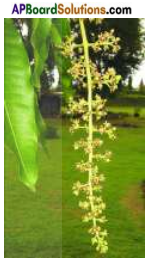
Eg: Datura, hibiscus, ipomoea, is called bisexual.
Question 2.
What is pollination? What happens to pollinated and non-pollinated flowers?
Answer:
- The process of pollen grains reaching the stigma from anther is known as pollination.
- After one week if we observe both pollinated and non – pollinated flowers. We find polinated flowers develop into fruits where as non – pollinated flowers do not.
![]()
Question 3.
What are the agents that help, in pollination? Describe how it takes place by taking an example.
Answer:
- Air, water, animals, insects, humans act as agents of pollination.
- They carry pollen grains from anther to the stigma.
- Insects like butterflies suck nectar from flowers.
- At that time pollen grains of that flower stick to the legs of the butterfly.
- When the butterfly goes to another flower for nectar, the pollen grain that have stuck to it’s legs fall on that flower.
Question 4.
What is fertilization? What happens after fertilization?
Answer:
- Fertilization: Fusion of units of male and female parts to form a structure called as zygote is called fertilization.
- After fertilization seed develops from the ovule and the ovary usually develops into a fruit.
- The entire process of fertilization and formation of zygote is known as Sexual reproduction.
- For the formation of a seed sexual reproduction is essential.
- The seed thus formed are dispersed to different places by agents like air, water, birds and animals and by human beings as well.
- These seeds grow into new plants under favorable conditions.
Question 5.
What is sexual reproduction?
Answer:
Production of baby plants or offsprings from the zygote is called sexual reproduction.
Question 6.
What is vegetative reproduction? Write an example for such reproduction.
Answer:
Vegetative reproduction: Production of new plants from vegetative parts of a plant i.e. root, stem and leaf is known as vegetative reproduction.
Example:
- Potato has a number of small depressions on its surface.
- These are known as eyes. Cut the potato into pieces such that there is an eye in each piece.
- Remove the eyes from some of these pieces. Fill two cups with soil.
- Plant the piece with eyes in one cup and label the cup as ‘with eyes” and those without eyes in another cup named as “Without eyes”.
- Water both cups daily and observe potato plants sprout in the cup where pieces with eyes are kept.
Question 7.
How does reproduction take place in Bryophyllum?
Answer:
- See the picture of the plant called Bryophyllum.
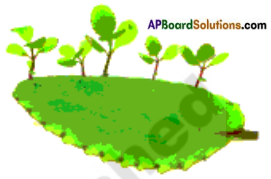
- We can see baby plants on the edge of the leaves.
- We can say that the Bryophyllum plant reproduces through its leaves.
![]()
Question 8.
Name some plants which can reproduce when a small branch of them is cut and planted in the soil.
Answer:
In our garden we grow plants like rose, hibiscus, and jasmine by cutting a small branch and planting them in the soil.
Question 9.
Do all flowers have four parts?
Answer:
The student can do this with the help of the teacher. Collect as many flowers from your surroundings as you can. See that you have at least a type of melon or gourd flower as well. Now observe different parts in each flower. Record your observations in the table given below.
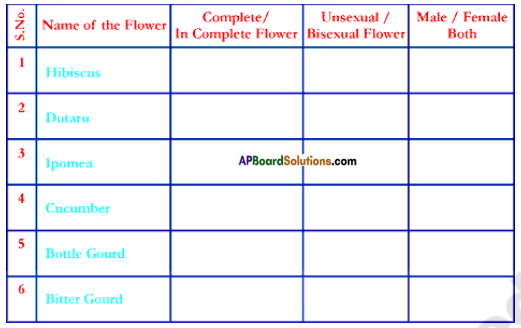
Question 10.
How do you identify the sexual parts of a flower?
Answer:
- Now take a stamen (androecium) from the datura flower, tap the stamen gently on a slide.
- We can see some grains fallen on the slide.
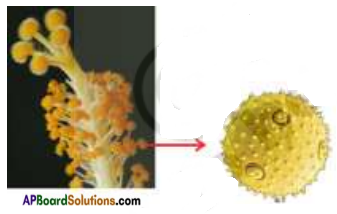
- Put a drop of water and observe these grains under the microscope.
- These grains are called pollen grains. Collect pollen grains from other flowers and observe under the microscope as well.
- Take the pistil of a datura flower as it is big enough to observe the internal parts.
- Cut the sections of the ovary of pistil as shown in figures a and b.
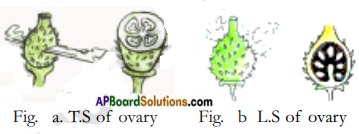
With the help of hand lens study the internal parts. - We see some small ball like structures called “ovules” can be seen arranged in different chambers.
Question 11.
How do you notice which flower part develops into fruit?
Answer:
- Collect a pistil and fruit from datura plant. Cut the transverse section of both ovary of pistil and fruit.
- Observe the internal structure of both the section cuttings with the help of a handlens.

- Collect pistil and fruit of cucumber, bhendi (Ladies finger), cotton and beans and do the above activity.
- Observe the similarities between the ovary and fruit of the same species.
- It is reasonable to conclude that an ovary develops into a fruit while the ovules develop into seeds. The seeds further produce new plants.
![]()
Question 12.
How do you observe ‘Self Pollination ‘and ‘Cross PollinationWhat role is played by male flower?
Answer:
- Observe a bottle-gourd plant in a garden. It has unisexual flowers i.e. male and female flowers separately.
- Select 10 female buds of bottle guard, cover with a polythene bag loosely tying the bag on a stalk.

- Make some tiny holes in the bag with the help of a pin.
- Two days later observe the buds blooming. (Now collect the pollen grains from a male flower of the Bottlegourd plant).
- Pluck the stamens of male flower and shake to collect pollen grain in a sheet of paper. Twisting cotton wool over the tip of a match stick prepares a brush.
- Now uncover five of the ten female flowers. Apply the pollen grain on to the stigma of these flowers with the brush.
- The pollen grains stick to the stigma.
- Cover the flowers again with polythene bag. Remove all male flowers from the plant.
- So that no pollen grain reaches the remaining female flowers.
- By this experiment we come to know that significant role is played by male flower in the formation of fruit.
- If transfer of pollen grains take place within the flower it is known as Self Pollination. Transfer of pollen grain from anther of one flower to stigma of another flower of same species is called Cross Pollination.
Question 13.
What happens to the pollen grain after pollination? What is fertilization?
Answer:
- Take two slides. Put 2-3 drops of water on them. Add some sugar grains to water on one side.
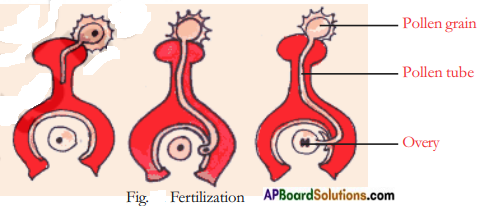
- Now put some pollen grains of Hibiscus flower on both the slides. After one hour observe under microscope. We find pollen grains germinate on the slide containing sugar grain.
- There are some substances present on the stigma which promote the germination of the pollen grains.
- During germination a tube grows from the pollen grain.
- This tube ultimately reaches the ovary through the style with the male part.
- This male part fuses with the female part in the ovule of the ovary.
- Fusion of units of male and female parts to form a structure called as zygote is called Fertilization.
Question 14.
What is budding? How do you demonstrate it?
Answer:
1) Yeasts grow with the help of a small bulb like outgrowth which increases in size and • breaks off from the parent plant to live independently.
2) This process of reproduction is called budding.
Demonstration:
- Take some water in a glass tumbler. Mix a tablespoon of sugar and half spoon of yeast powder you get in the market, in the glass tumbler.
- Cover the glass and leave it undisturbed for a day.
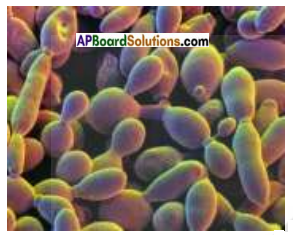
- On the next day place a drop of the solution on a slide and cover it with a cover slip and examine it under a microscope.
- We can see budding yeast cells as shown in the figure, (they look like water bubbles growing new ones on them).
![]()
Question 15.
What is mould? How can you do an activity to show it?
Answer:
- Take a slice of bread cover it with a vessel and leave it undisturbed for two or three days.
- Thereafter you will find the slice covered with grey coloured fungus called bread mould.
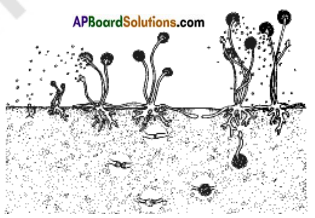
- Let it stand for three or four days. The whole growth appears like a black powder like matter.
- Transfer this powder with a thin stick on a fresh slice of moist bread.
- Observe what happens after every day and note your observation.
- The black powdery portion of bread mould contains several spores.
Question 16.
What is thalamus in a flower?
Answer:
Let us hold a Dhatura flower by its stalk. This stalk is green in colour and has a slightly swollen head. This is called thalamus. It is the seat on which the parts of a flower are present.
Question 17.
Explain what are calyx and sepals in a flower.
Answer:
- Now let us observe the part that comes just above the thalamus.
- There is a green tube like structure called Calyx.

- The edges on the part towards the petals have thin leaf like structures called sepals.
- The lower ends of-sepals are fused to form the tube like structure.
Question 18.
Write about corolla.
Answer:
- If we remove the tube of fused sepals in the flower carefully we see
- There is a funnel shaped corolla. This is formed of fused petals.
Question 19.
What is the male part or Androecium of a flower?
Answer:
- After removing the petals we can see soft elongated structures attached to these petals.
- They are called stamens.
- There is a bulb like structure at the top of each stamen that is called pollen sac or anther.
- Just below it a fine whitish thread like structure called filament attaches the anther to the petal (in Datura).
- So stamen has an elongated filarftent and a bulb like pollen sac.
- Stamens of the flowers are together called the male part or androecium.
![]()
Question 20.
What is Gynoecium? How do you find it is a flower?
Answer:
- As we remove petals, right on the thalamus is seated a bulb like structure called ovary.
- Just above it a fine tube like structure called style goes up ending in a somewhat flat bead like structure called stigma.
- This whole structure from ovary to stigma is the pistil or one female reproductive part.
- All the parts present on the pistil together called as gynoecium.
Question 21.
What do you see in sun flower?
Answer:
- Sun flower looks like a single flower.
- But is actually a bunch of flowers.
- The small flowers in the bunch are called ‘florets’.
- The florets in the centre are called disc florets.
- The florets along the rim are called ray flowers.
Question 22.
How are flowers classified on the basis of number of parts present in them?
Answer:
Flowers are classified as
a) Complete flower b) Incomplete flower c) Unisexual flower d) Bisexual flower
Question 23.
What is Penicillin? Who discovered it?
Answer:
Alexander Fleming a Scottish scientist, discovered that a certain kind of mould (Penicillium) produces a substance, named after the mould, called Penicillin, which can destroy many kinds of disease causing bacteria. Penicillin came to be know as an antibiotic and saved the lives of many soldiers in World War – II.

Question 24.
Observe various types of stamens of different flowers.
Answer:

Question 25.
Observe the different types of pistil drawn below.
Answer:
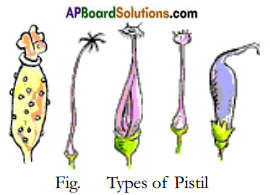
![]()
Question 26.
Write the differences between pollination and fertilization.
Answer:
| Pollination | Fertilization |
| 1) It is the transfer of pollen grains from anther to stigma. | 1) It is the fusion of a male and female gametes. |
| 2) External agents like water, wind and insect are needed. | 2) It does not require external agent. |
Question 27.
Draw a flow chart for Reproduction in plants.
Answer:

Question 28.
What is asexual production- How do you appreciate this?
Answer:
- Reproduction of plants from all such parts other than the flower is asexual reproduction.
- It is a great thing in nature because reproduction in plants is not confined only to sexual reproduction.
- By way of such processes, we could get good vegetation.
Question 29.
Write the importance of flowers. Name some of them.
Answer:
- Flowers are usually the most attractive part of any plant.
- Flowers are so attractive and colourful. Because they attract insects, human beings, etc. to get cross – pollination.
- Reproduction is possible through flowers also.
- Datura, Chinarose (Hibiscus), Cucumebr, Bottlegourd, Tridax, Sun flower, Ipomea etc.
![]()
Question 30.
The student is advised to complete the table given below taking the help of the teacher.
Answer:
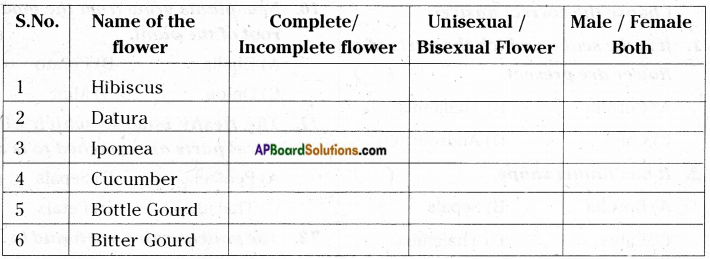
Question 31.
How are the pesticides causing destruction to our beautiful nature?
Answer:
- Birds and insects are the natural agents for pollination.
- Nowadays farmers use pesticides to control pests on crops.
- The enormous use of pesticides kills insects also.
- It effects pollination.
- Crop yield become reduced particularly in sun flower crop.
- The rate of pollination is reduced because of lack of insects in the fields.
- Think! How we destroy our beautiful nature.
Question 32.
We often find that some plants grow from their cuttings or some other parts. Can you name some such plants?
Answer:
| S.No. | Name of the Plant | Plant part from which new plant produced |
| 1. | Potato | New plants grow from eyes in the tuber |
| 2. | Onion | New plants grow from bulbs |
| 3. | Sugarcane | Stem grows roots at the nodes |
| 4. | Bryophyllum | New plants grow from buds on the leaf. |
![]()
Question 33.
Look at the picture.
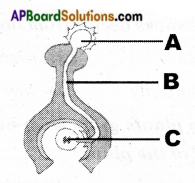
- Identify the parts A, B, C.
- Name the type of reproduction seen here.
- Which part is converted into seed?
- What is meant by Fertilization?
Answer:
- A – Pollen grain; B – Pollen tube; C – Ovary
- Sexual reproduction.
- Ovules develop into seeds.
- Fusion of units of male and female parts (Pollen grain and Ovules) to form a structure called zygote is called fertilization.